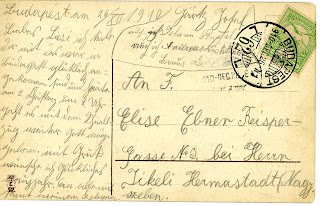Funny thing about love. We know it when we feel it. We know it when we see it.
But I didn’t always know about the love expressed in language as flowery as the blue-bedecked bicycle pictured on the front. In fact, before last year, I didn’t know this postcard existed.
It was one of scores of missives my grandmother had saved for almost seventy years. “Trash or treasure?” My brothers and I debated, in a frenzy of sorting after my mother’s death. We squinted at the illegible writing, written in an ancient German script that most present-day Germans can’t read much less a German major like me. We decided to keep them, but I figured they’d languish for years in “Box 14, Gartz Correspondence” and end up summarily tossed.
Enter fate.
My brothers and I traveled to Transylvania in 2007 on a family roots-finding mission. In Sibiu (called Hermannstadt by the Germans), we met Professor Uli Wien who was researching the history and immigration of Siebenbürgen Germans—people like our grandparents. Uli asked for our email addresses.
I forgot all about Uli until the summer of 2009, when he emailed me. “Do you by any chance have any letters to or from your grandparents?”
Did I have letters! My heart leapt at what this meant. Perhaps Uli could help me decipher the inscrutable writing! That put me on a mission to look at the letters closely for the first time in the fifteen years since Mom’s death—and I began to tease out some authors’ names.
F[räulein]Elise Ebner
Reisper Gasse [Street]
c/o Mr. Ji[c]keli [the family for whom my grandmother worked]
Hermannstadt
Nagyszeben
I recognized my grandfather’s signature: “Josef Gärtz,” and I knew I had a treasure.Printed under the bicycle on the front:Herzlichen Glückwunsch zum Namenstag. “Heartfelt Good Wishes for your Name Day.”
I sent a xerox of the writing to Uli, and he deciphered into modern German those words written one hundred years ago today. I translated Josef’s sincere, flowery note into English, its tinges of 19th century formality not diminishing its sweetness:
I wish you much happiness and best of health on your cherished Name Day, so you can keep this happy day blooming for many years into the future. A joyful “Hail! and Cheers!” rings out on this day of the flower. [He may be comparing Lisi to a flower]. Long live the pretty girl and faithful Lischen [an endearment for Lisi—like sweet Lisi].
Yours faithfully,
J[osef] G[ärtz]
Neppendorf, November 18. 1910
[Neppendorf was my grandfather’s home town]
Celebrating one’s Name Day has been a European tradition for centuries — and was a bigger event than a birthday. Parties, gifts, candy, and cards like this one, all were part of the day. Josef and Lisi were Lutherans, and on the Lutheran calendar, Elisabeth’s Name Day is November 19th. Josef mailed this postcard a day ahead, his loving words now reaching us across the span of 100 years.
I know love when I see it.


Sis, I knew Grandpa Gartz GpG) as a very funny man who loved his Lisi. I never had any idea how romantic he was or how much the language of the time was not what we later herd in the US in the 1950s – 70s as they had adapted. GpG successfully woo’ed our GmG and got her to give up country and language and a steady job for a high risk adventure that eventually included us. Today in the age of instant everything, global travel and the web it is hard to imagine what a commitment this was as… Read more »
Linda,
This is fascinating–how the language changed so much, I had no idea. How amazing it must be to finally know what that writing means. Will you have more letters translated?